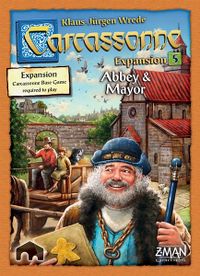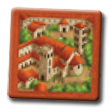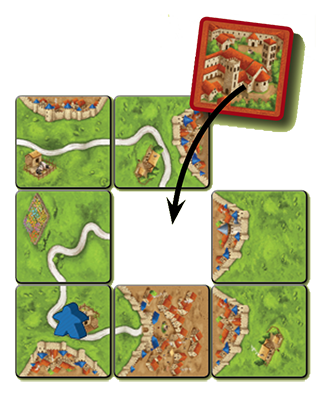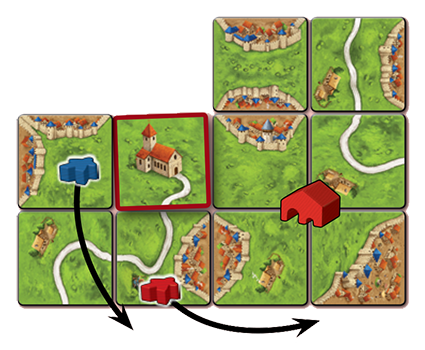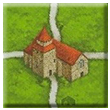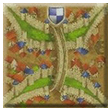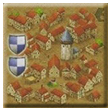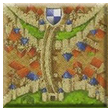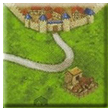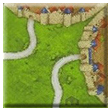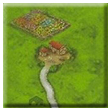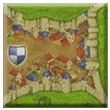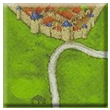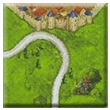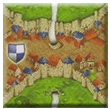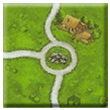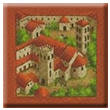Abația și primarul
Informații generale și comentarii
Extensia Abația și primarul a fost lansată în ediția nouă în anul Template:Year ro de Hans im Glück. A fost lansată original în ediția veche în anul Template:Year ro.
Această extensie introduce noi cartonașe de teren incluzând cartonașele speciale cu abație, care lasă jucătorii să umple găuri de pe suprafața de joc. De asemenea, introduce noi pioni cu caracteristici speciale:
- Primarul, un meeple care poate fi plasat numai în oraș și care are puterea variabilă
- Căruța, un meeple care se poate muta pe alt teritoriu după evaluare
- Moșia, un pion special care declanșează evaluarea câmpului
Conținut
- 12 cartonaşe de teren
- 6 cartonaşe cu abaţii
- 6 primari
- 6 căruţe
- 6 moșii
Noile cartonașe de teren
Noile cartonaşe de teren trebuie ataşate la fel ca şi cele din jocul de bază.
La început îţi explicăm cartonaşele speciale ale acestei extensii:
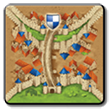 |
There are two separate cities on this tile. The city with the coat of arms ends after the bridge in the lower field. This is important for field scoring. |
|
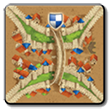 |
There are two separate cities on this tile. |
|
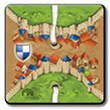 |
The road on this tile is unbroken. The top part of the road separates two fields, the lower part does not. This is important for field scoring. [1] |
|
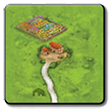 |
This road ends in the field. |
|
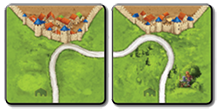 |
The road on each of these tiles touches the city, creating 3 separate fields. |
|
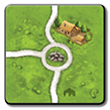 |
The road does not end on this tile. Instead, it branches into 3 directions. [2] |
|
Reguli
Pregătire
Împarte fiecărui jucător câte 1 cartonaş cu abaţie. Dacă participă mai puţin de 6 jucători la partidă, depune abaţiile rămase în cutie. Nu veţi avea nevoie de acestea în acestă partidă. Apoi amesteci noile cartonaşe de teren cu celelalte cartonaşe, le aranjezi ca şi până acum în mai multe teancuri acoperite şi le depui pe masă. Dă fiecărui jucător cei 3 pioni din lemn de culoarea lui: 1 primar, 1 căruţă şi 1 moşie. Toţi jucătorii îşi depun aceşti pioni împreună cu meepleşii în rezerva lor personală.[3]
Abația
1. Ataşarea unui cartonaş de teren
Dacă doreşti să ataşezi o abaţie, la începutul turului tău nu tragi niciun cartonaş. În loc de această acţiune ataşezi o abaţie. Poţi ataşa abaţia în orice loc în care cele 4 laturi ale spaţiului liber sunt înconjurate de cartonaşe şi unde în spaţiul gol mai există loc pentru 1 singur cartonaş. Adică abaţia poate fi depusă numai într-o „gaură”. Nu contează ce fel de elemente de peisaj sunt pe cele 4 laturi. Este indiferent dacă este vorba de un câmp, un drum, sau de porţiuni de oraş, abaţia se potriveşte întotdeauna. Dacă nu există o asemenea „gaură”, nu ai posibilitatea să ataşezi abaţia.
Dacă unul sau mai mulți jucători nu și-au plasat abația până când ultimul cartonaș a fost tras și atașat, atunci o pot face, în ordinea acelor de ceasornic începând cu persoana care a atașat ultimul cartonaș de teren, atât timp cât plasarea acesteia este în conformitate cu regulile. Apoi urmează evaluarea finală.[4][5]
2. Plasarea unui meeple
Abaţia trebuie tratată ca orice mănăstire. Poţi să îți plasezi un meeple drept călugăr în abaţie.[6]
3. Scoring a feature
Dacă ţi-ai ataşat abaţia (şi eventual ţi-ai plasat un meeple pe cartonaş), toate cele 4 laturi limitrofe sunt considerate finalizate. După aceasta vei evalua în mod obişnuit drumurile, oraşele şi mănăstirile finalizate de abaţie. Călugărul din abaţie se evaluează ca şi un călugăr dintr-o mănăstire obişnuită.[7]
Evaluarea abației însăși, atât în timpul jocului cât și la sfârșitul jocului, este identică cu evaluarea mănăstirii.
Primarul
2. Plasarea unui primar
3. Declanşarea unei evaluări
Puterea primarului este dată de numărul de blazoane din oraș. Primarul reprezintă ca valoare atâţia meepleși câte blazoane sunt în oraș. Dacă mai sunt prezenţi și unul sau mai mulți meepleși ai altui/altor jucători în oraș, se aplică următoarele reguli:
- Fiecare normal meeple are puterea 1. [11]
- Fiecare meeple mare[12] are puterea 2.
- Fiecare primar are puterea echivalentă cu numărul de blazoane din oraș. Dacă nu există blazoane, primarul are puterea 0.
When scoring a city, each player adds the strength of their meeples in the city. The player with the highest strength scores the points for that city. In case of a tie, all tied players score full points.
La evaluarea unui oraș fiecare jucător trebuie să adauge puterea meepleșilor din oraș. Jucătorul cu puterea cea mai mare primește punctele pentru acel oraș. În caz de egalitate se acordă tuturor jucătorilor implicaţi numărul integral de puncte.
Valoarea unui oraș nu este afectată de primar.
When a city is completed, mayors in that city are returned to their respective supplies.
Când evaluezi un oraș în care se află doar unul sau mai mulți primari, dar în oraș nu există niciun blazon, fiecare primar are puterea 0 și nu primește puncte pentru oraș.
![]() Întrebare: Blue has a mayor in a city with no coats of arms. Does the city count as occupied? And if so, when the city is scored, will Blue score points?
Întrebare: Blue has a mayor in a city with no coats of arms. Does the city count as occupied? And if so, when the city is scored, will Blue score points?
Răspuns: The city is occupied. The mayor has no "strength," so it counts as if there is no meeple, and scores no points.
Moșia
2. Placing a barn
You may place a barn instead of placing a meeple. [13] If you place a tile that creates a junction where 4 tiles connect to create an open field, you may place your barn directly on that junction. In other words, the corner of each tile forming this junction must only depict a field in order for a barn to be placed there.
You may place your barn on a field already occupied by farmers. You may not, however, place your barn on a field already occupied by another barn. [14] Once placed, a barn remains in play until the end of the game. [15]
3. Scoring a feature
FARMER SCORING AFTER BARN PLACEMENT
If there are farmers in the field where you place your barn, that field is scored immediately, [16] just as it would be at the end of the game. Therefore, the player with the most farmers in that field scores 3 points per completed city in the field. It does not matter which player placed the barn that initiated this scoring.
Then, all farmers occupying that field are returned to their respective supplies.
FARMER SCORING BY FIELD CONNECTION
A field occupied by a barn may NOT be occupied by farmers. If you place a tile that connects a field occupied by one or more farmers to a field occupied by a barn, the connected field is scored during the scoring phase of that turn (after 2. Placing a meeple). The player with the most farmers in that field scores only 1 point per completed city.
Then, all farmers occupying that field are returned to their respective supplies.
BARN SCORING AT GAME END
At the end of the game, you score 4 points per completed city in the field your barn occupies. If multiple barns occupy the same field, all concerned players score full points.
Căruța
2. Placing a wagon
3. Scoring a feature
When scoring a feature (road, city, monastery, etc. [18]) a wagon occupies, the wagon is treated like a normal meeple.
After scoring, you may return the wagon to your supply, or you may move it to a directly adjacent unoccupied, incomplete feature (road, city, monastery, etc. [18]). Adjacent, in this case, means that the feature is on the same tile or a tile orthogonally or diagonally adjacent to the tile the wagon is moving from. [19] If there are no such features for your wagon to move to, it must be returned to your supply.
If several wagons are involved in a scoring phase, each concerned player chooses whether to return or move their wagon in clockwise order starting with the active player.
![]() Întrebare: Can you deploy a wagon to a city, score it, and then move the wagon to another feature, all in one turn? Or can you only move the wagon instead of deploying a normal meeple?
Întrebare: Can you deploy a wagon to a city, score it, and then move the wagon to another feature, all in one turn? Or can you only move the wagon instead of deploying a normal meeple?
Răspuns: The wagon can be deployed instead of a normal meeple. If the city is immediately completed, then it’s scored (wagon or "normal" meeple). After scoring, the wagon can be moved. All of that is possible in a single turn. [Wagon movement is not in place of deployment.]
Alte extensii
Această secțiune conține informații adiționale despre interacțiunile cu alte extensii Carcassonne.
Abația
- You can occupy an abbey with the following figures:
- Normal meeple, the standard option (Base game)
- Abbot (Base game - The Abbot), since abbeys behave like monasteries.
- Large meeple (Exp. 1 - Inns and Cathedrals)
- Wagon (Exp. 5 - Abbey & Mayor)
- Ringmaster (Exp. 10 - Under the Big Top)
- Phantom (The Phantom)
- Exp. 1 - Inns and Cathedrals: Clarification in Q&A format:
![]() Întrebare: If cities with trade goods are completed by placement of an abbey tile, are the goods tokens awarded as usual to the player placing the abbey tile?
Întrebare: If cities with trade goods are completed by placement of an abbey tile, are the goods tokens awarded as usual to the player placing the abbey tile?
Răspuns: Yes, as the player completed the city.
- Exp. 2 - Traders and Builders: If a player completes a feature with an abbey tile and his or her builder is on the feature, the feature does not get “extended” by the abbey (as the abbey is a separate feature), so the player does not get another tile (i.e. no double turn).
- Exp. 6 - Count, King and Robber:
- The rules that restrict the placement of monasteries next to already placed shrines (and vice versa) also restrict the placement of abbeys.
- A shrine can challenge an abbey, and vice versa, because the abbey is also a monastery.
- Besiegers - Cathars - Siege A knight (i.e. meeple) in a besieged city from can escape via a abbey, as it is a monastery.
Moșia
- Exp. 2 - Traders and Builders:
- If you have the most farmers in a field where a barn is placed, you score 1 additional point per completed city (4 points total) if your pig is in that field. Furthermore, if you have the most farmers in a field that becomes connected to a field occupied by a barn, you score 1 additional point per completed city (2 points total) if your pig is in that field.
- You can place your pig on a tile that connects your farmer to the barn. After scoring your pig, return it to your supply.
![]() Întrebare: May the pig be placed on a farm that was just connected to a farm with a barn, i.e. on the newly placed tile (immediately before scoring)?
Întrebare: May the pig be placed on a farm that was just connected to a farm with a barn, i.e. on the newly placed tile (immediately before scoring)?
Răspuns: Yes, the pig may be placed in already occupied features [and the normal "Move Wood" phase still happens].
- If a player has an abbey left, draws the very last tile, and plays it to a feature where he or she has a builder, the abbey may be played on the second part of the double-turn.
- Exp. 3 - The Princess and the Dragon:
- A barn may not be eaten by the dragon.
- A barn may be placed on a tile with a volcano.
- You may not place the fairy by a barn, as the barn is not a meeple.
- A barn not be placed using a magic portal.
- Exp. 4 - The Tower:
- A barn may not be captured by a tower.
- You may not place your barn on a tower.
- Exp. 6 - Count, King and Robber:
- You can move meeples from the cathedral district to an abbey, as an abbey has all of the characteristics of a monastery.
- The city of Carcassonne counts as a city when scoring a barn.
- The barn cannot be placed in the city of Carcassonne.
- If your barn placement of field connection triggers a field scoring in which you score no points, you may place a meeple in the city of Carcassonne.
![]() Întrebare: If I place a barn on a field on which another player has farmers, causing him/her to score while I score nothing, can I move a meeple to the city of Carcassonne?
Întrebare: If I place a barn on a field on which another player has farmers, causing him/her to score while I score nothing, can I move a meeple to the city of Carcassonne?
Răspuns: Yes, that's allowed. Only immediately scored points matter. It doesn't matter that the barn is certain to score at the end of the game.
- If a barn placement or field connection triggers a field scoring, you may move meeples from the market in the city of Carcassonne to that field. Score that field as normal, and return all farmers in that field to their respective supplies. (It doesn't matter that the barn is certain to score at the end of the game.)
![]() Întrebare: Are the meeples in the market district only used at the end of the game?
Întrebare: Are the meeples in the market district only used at the end of the game?
Răspuns: This is no longer entirely true. Placing of a barn, and the subsequent scoring of the field, does count as an opportunity to remove a meeple from the city of Carcassonne. Now that fields can be scored at times other than at the end of the game, meeples from the market can be moved to fields earlier in the game. That occurs immediately after the placement of the barn, and before the fields are scored. [Joining of a farm containing a meeple to a field with a barn would logically be another opportunity – Chris O.]
- You can move meeple from the market district to a field with a barn (and score it) if a field scoring is triggered. (This can happen at the end of the game or with joining of a barnless field to one with a barn.)
![]() Întrebare: Can a meeple be moved from the city of Carcassonne to a field with a barn?
Întrebare: Can a meeple be moved from the city of Carcassonne to a field with a barn?
Răspuns: Yes, the farmer will be scored immediately, and so scores only 1 point per city and is (importantly) not on the field during the final scoring proper. [Obviously, placement of a meeple in this manner still requires a scoring trigger as per the fundamental rules – this could be at the end of the game or with joining of a barnless field to one with a barn – Chris O.]
- The pigsty (The River II expansion) only affects field scoring for farmers. Barns do not score additional points from the pigsty.
- Exp. 8 - Bridges, Castles and Bazaars When scoring a field, whether for farmers or barns, castles are worth 1 more point.
- Besiegers - Cathars - Siege A besieged city scores double points if it lies on a field with a barn.
- The Markets of Leipzig: The city of Leipzig counts as a city when scoring a barn.
Rezumat pentru evaluare
Scoring fields with a barn
| SCORING DURING THE GAME |
1. Scoring a field when placing a barn
If farmer majority –
- 3 points per completed city adjacent to farm
- 4 points per castle adjacent to farm
- (+1) point per castle or completed city with pig (then return pig to owner’s supply)
- (+1) point per castle or completed city with pigsty tile
- (x2) if besieged city
2. Scoring a connected field
If farmer majority –
- 1 point per completed city adjacent to farm
- 2 points per castle adjacent to farm
- (+1) point per castle or completed city with pig
- (+1) point per castle or completed city with pigsty tile
- (x2) if besieged city
| SCORING AFTER THE GAME |
Evaluarea moșiei
- 4 point per completed city adjacent to farm
- 5 points per castle adjacent to farm
- (x2) if besieged city
Primarul și căruța
- Exp. 3 - The Princess and the Dragon:
- Both figures may be placed using the magic portal. They may only be placed in features in which they may normally be placed.
- Both figures may be eaten by the dragon.
- Both figures may be seduced by a princess.
- Exp. 4 - The Tower:
- Both figures may be captured by the tower.
- Both figures may not be placed on a tower.
- Exp. 6 - Count, King and Robber: Both figures may be placed in the city of Carcassonne with the following exceptions:
- The mayor may only be placed in the castle quarter.
- The wagon may be placed anywhere but in the market.
- Exp. 8 - Bridges, Castles and Bazaars Both figures may occupy a castle. However, the mayor (now the lord of this castle) cannot score points for that castle, as that castle does not have any coats of arms.
- The Flier (Flying Machines)
- The mayor can be a flier. However, the mayor can only land on an unfinished city. If an unfinished city is not available on the tile where the mayor lands, the mayor returns to the player’s supply. (2/2013)
- The Festival The barn can be removed by a Festival tile, before the end of the game. (12/2014)
- Besiegers - Cathars - Siege Both figures, if placed in a besieged city, can escape via a monastery or any equivalent feature, such as an abbey (although it would be quite amusing if the mayor stayed, like a captain going down with the ship.)
Noile cartonașe
- Exp. 6 - Count, King and Robber: The length of a road with the roundabout tile (e.g. for the purposes of the Robber tile) is the total number of tiles in the road, not simply the longest distance between two ends. The road has three ends which have to be closed, but the result is that it's likely to be bigger.
- The Tunnel: The road with a tunnel does indeed count as being "broken" if one is using The Tunnel expansion, in which case the tile contains two as yet unconnected tunnel openings.
Reguli neoficiale
- The wagon can move to the next complete, or uncontested and incomplete, feature. This lets it roll across the board to uncontested features. (Thanks to viberunner)
- The mayor cannot be captured by the tower. (Thanks to viberunner)
- The wagon cannot be eaten by the dragon or captured by the tower. (Thanks to viberunner)
- The mayor is laid flat in the same way as farmers so that you can tell at a glance which cities contain mayors. (Thanks to Joff)
- The pigsty tile can score an extra point per city when there is a barn on the farm.
Referință pentru cartonașe
Total tiles: 12
Unele cartonașe au o ilustrație mică pe acestea. Literele din paranteze arată care ilustrație este pe fiecare cartonaș:
Numărul total de cartonașe cu abație: 6
Note de subsol
Pentru licențierea și semnificația pictogramelor te rugăm să vizitezi Pagina pictogramelor.
- ↑
 The road with a tunnel does indeed count as being “broken” if one is using the The Tunnel expansion from the 1st Edition. See Other expansions for more details.
The road with a tunnel does indeed count as being “broken” if one is using the The Tunnel expansion from the 1st Edition. See Other expansions for more details.
- ↑
 All of the branches have to be completed in order to score the road scoring. See Other expansions for more details on the interaction with the Robber tile from Count, King and Robber.
All of the branches have to be completed in order to score the road scoring. See Other expansions for more details on the interaction with the Robber tile from Count, King and Robber.
- ↑
 Statut oficial: Primarul și căruța sunt meepleși datorită regulilor de plasare și de afectare a majorității. Moșia este un pion special, nu un meeple.
Statut oficial: Primarul și căruța sunt meepleși datorită regulilor de plasare și de afectare a majorității. Moșia este un pion special, nu un meeple.
- ↑
 Acest paragraf a fost adăugat în versiunile HiG și RGG ale Big Box 2 și realmente contrazice un FAQ mai vechi (care a stabilit că un cartonaș cu abație nu poate fi plasat după plasarea ultimului cartonaș de teren). Totuși, nu este adăugat în regulile ediției noi.
Acest paragraf a fost adăugat în versiunile HiG și RGG ale Big Box 2 și realmente contrazice un FAQ mai vechi (care a stabilit că un cartonaș cu abație nu poate fi plasat după plasarea ultimului cartonaș de teren). Totuși, nu este adăugat în regulile ediției noi.
- ↑
 Atunci când o abație este atașată în acest fel, un meeple poate fi plasat pe abație ca în mod obișnuit. Dacă abația este înconjurată complet și apoi imediat finalizată este evaluată ca într-o tură obișnuită. Apoi urmează evaluarea finală. (5/2013)
Atunci când o abație este atașată în acest fel, un meeple poate fi plasat pe abație ca în mod obișnuit. Dacă abația este înconjurată complet și apoi imediat finalizată este evaluată ca într-o tură obișnuită. Apoi urmează evaluarea finală. (5/2013)
- ↑
 Când este plasat un cartonaș cu abație, un meeple nu poate fi plasat lângă abație (de exemplu, ca cavaler), din moment ce abația ocupă întregul cartonaș. Abația de pe cartonaș nu este înconjurată de oraș. Prin urmare, un meeple de pe acest cartonaș este un călugăr.
Când este plasat un cartonaș cu abație, un meeple nu poate fi plasat lângă abație (de exemplu, ca cavaler), din moment ce abația ocupă întregul cartonaș. Abația de pe cartonaș nu este înconjurată de oraș. Prin urmare, un meeple de pe acest cartonaș este un călugăr.
- ↑
 Abațiile pot închide orașe și drumuri dar nu fac parte din ele însăle. Reține acest lucru când evaluezi drumuri, orașe și, de asemenea, câmpuri.
Abațiile pot închide orașe și drumuri dar nu fac parte din ele însăle. Reține acest lucru când evaluezi drumuri, orașe și, de asemenea, câmpuri.
De exemplu: Să zicem că există un oraș finalizat de către abație și un câmp care are doar o latură comună cu cartonașul cu abație. În acest caz, un țăran care deține majoritatea aflat pe acest câmp nu va primi niciun punct pentru acel oraș, din moment ce nu este conectat direct cu orașul. - ↑
 Reține că și primarul este un meeple. Regulile folosesc „meeple”, dar înseamnă „meeple obișnuit”, deoarece (probabil că) regulile vorbesc sunt scrise doar din punctul de vedere din care se joacă doar cu jocul de bază și această extensie.
Reține că și primarul este un meeple. Regulile folosesc „meeple”, dar înseamnă „meeple obișnuit”, deoarece (probabil că) regulile vorbesc sunt scrise doar din punctul de vedere din care se joacă doar cu jocul de bază și această extensie.
- ↑
 Oricare meeple, incluzând primarul, care este plasat într-un oraș este considerat a fi un cavaler. Așa că acest enunț este redundant.
Oricare meeple, incluzând primarul, care este plasat într-un oraș este considerat a fi un cavaler. Așa că acest enunț este redundant.
- ↑
 Primarul nu poate fi plasa într-un oraș care conține deja o căruță. Ambii sunt meepleși (potrivit definiției din reguli), așa că orașul este deja ocupat de căruță.
Primarul nu poate fi plasa într-un oraș care conține deja o căruță. Ambii sunt meepleși (potrivit definiției din reguli), așa că orașul este deja ocupat de căruță.
- ↑
 În afara meepleului mare și primarului, toți ceilalți meepleși care nu sunt menționați aici au mereu puterea 1, aceeași ca un meeple normal: căruța, directorul de circ (În arena circului) și fantoma (Fantoma).
În afara meepleului mare și primarului, toți ceilalți meepleși care nu sunt menționați aici au mereu puterea 1, aceeași ca un meeple normal: căruța, directorul de circ (În arena circului) și fantoma (Fantoma).
- ↑
 Un meeple introdus în Hanuri și catedrale.
Un meeple introdus în Hanuri și catedrale.
- ↑
 The barn is not a meeple.
The barn is not a meeple.
- ↑
 Fields with barns can be joined resulting in fields with more than one barn.
Fields with barns can be joined resulting in fields with more than one barn.
- ↑
 The barn can, however, be removed by a Festival tile. See Other expansions for more details.
The barn can, however, be removed by a Festival tile. See Other expansions for more details.
- ↑
 The word "immediately" here means that farmers are scored then removed during the normal scoring phase of this turn (as opposed to staying on the farm until the end of the game). The placement of a barn does not stop play for a separate scoring phase for the farmers. Thus, the normal “move wood” portion of the turn occurs before the farmers are scored. (10/2012)
The word "immediately" here means that farmers are scored then removed during the normal scoring phase of this turn (as opposed to staying on the farm until the end of the game). The placement of a barn does not stop play for a separate scoring phase for the farmers. Thus, the normal “move wood” portion of the turn occurs before the farmers are scored. (10/2012)
- ↑
 Note that the wagon is also a meeple. The rules use the word "meeple" but meaning "normal meeple", as if considering the expansion being played with the base game alone.
Note that the wagon is also a meeple. The rules use the word "meeple" but meaning "normal meeple", as if considering the expansion being played with the base game alone.
- ↑ 18.0 18.1 18.2
 This feature list should be extended to cover all claimable features available except fields and gardens (only valid for abbot meeples):
This feature list should be extended to cover all claimable features available except fields and gardens (only valid for abbot meeples):
- Roads
- Cities
- Monastic buildings:
- Monastery
- Abbey
- Shrine
- German monastery (placed as a monk or as an abbot)
- Dutch & Belgian monastery (placed as a monk or as an abbot)
- Japanese building (placed as a monk or as an abbot)
- Darmstadt church
- Baba Yaga's hut
- German castles
- German cathedrals
- ↑
 The wagon rules in Abbey and the Mayor (1st Edition) were different in the following aspects:
The wagon rules in Abbey and the Mayor (1st Edition) were different in the following aspects:
- Adjacency: The wagon could only move to an unoccupied, incomplete feature connected by a road or sharing a surface/edge/wall:
- Cases allowed:
- Road to road through a crossing
- Road to any claimable feature and vice versa: city (through a gate), monastery (or equivalent feature such as an abbey), etc.
- A city to an adjacent abbey and vice versa
- A city to a monastery within and vice versa
- Cases not allowed:
- Two cities with touching walls or tips on the same or on different tiles.
- Two cities connected by "small roads" where meeples cannot be placed.
- Two cities crossing via bridges but no connected via roads.
- Two roads separated by a feature (are any aspect on a tile that can be claimed by a meeple or that triggers any function)
- A road touching a city wall with no gate
- A road running through a city via a tunnel or passing over via a bridge
- Cases allowed:
- Placement: the wagon could be placed on any tile of the chosen unoccupied, incomplete feature.
- Adjacency: The wagon could only move to an unoccupied, incomplete feature connected by a road or sharing a surface/edge/wall:
- Editor Manual - Old numbered parameters - RulesPlacingTile
- Editor Manual - Old numbered parameters - RulesPlacingMeeple
- Editor Manual - Old numbered parameters - RulesScoring
- Editor Manual - Old numbered parameters - FAQ
- Editor Manual - Old numbered parameters - Tile
- Old template
- Old template - FootnoteIconPara ro
- Category:A doua ediție
- Category:Extensii majore din a doua ediție
